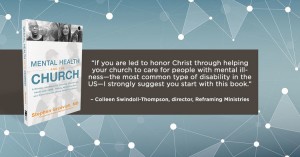I was invited to be a part of the “Book Launch Team” for a new resource for churches that I think is invaluable for any ministry considering outreach to those that struggle with mental health issues. In Montana, where the need is great and services are often lacking, the Church has a great opportunity to be a positive agent for change. As your partner in ministry, I could not recommend this book more highly. –Chris Haughee, chaplain.
In my role as the chaplain to severely emotionally disturbed in an intensive residential care facility has led to me a lot of conversations with parents that struggle to find a faith community that will extend love and grace to them as they work to parent in a very difficult situation. I have lost count of how many times I have heard the phrase, “We used to go to church until…” and then they tell a story about how their child acted out, the church felt ill equipped to handle emotional and mental health challenges, and then the family was either told they were not welcome or were simply marginalized to the point of making regular attendance improbable.
As a ministry professional, I have been encouraged by many churches who want to become trauma-informed and better equipped to understand the mental health challenges that 20-30% of their congregations and communities are dealing with. The Church is God’s representative on earth of the ideals of the Kingdom of God—God’s desire that everyone know the unconditional love of Jesus Christ and the sense of belonging and hope that we need as social beings. The pastors and churches I work with, once aware of the needs of children, youth, and adults with mental health diagnoses, desire to know, “What can we do?” As Dr. Grcevich points out, “churches have far more opportunities” for ministry “than they have resources” (p. 91). So, many churches balk at engaging in mental health ministries because it looms too large a task and too fraught with potential disaster. Their fears keep them from engaging, and it is felt that resources and energies are better spent in ministries where they feel greater competency.
Over the last six years, in working at a children’s therapeutic residential facility, I have grown in my appreciation and admiration of the good work that so many in mental health care have been doing for the “least and the lowly” that Jesus spoke of. The work in unglamorous, unheralded, and it can be difficult to know how to do what is best for your clients when the resources you have are stretched so thin. The work is messy and it is also glorious. It is a beautiful thing to see those who have been misunderstood and hurting embrace healing and hope. The mental health community is doing great work, but often feels disconnected from the work of the Church or judged by it.
Two great forces for good—the Church and Mental Health—often stand apart from one another, distrust one another, and don’t see where collaboration and partnership could result in a tremendous force for good, for healing, and for wholeness for millions of people. What is needed are those that have the wisdom to “connect the dots” and show all of us why, how, and where we can best work together!
Into this divide between these great forces for good steps the ministry of Dr. Stephen Grcevich and Key Ministry. The book, Mental Health and the Church, by Dr. Stephen Grcevich provides a much needed bridge between the healing work of therapists and mental health professionals and the wonderful work of the Church. The book lays out both the case for the Church to engage in mental health ministry as well as the practical tools and insights needed for ministering well to this underserved segment of our communities.
Part One explains the problem and why the Church should care. As Grcevich explains, over 43 million American adults have experienced at least one mental illness. When you factor in children’s mental health, a field I am well acquainted with, “more than fifty million Americans today experience at least one diagnosable mental health disorder on any given day!” (p. 19) When these individuals come to the church and are misunderstood or judged for their behavior as not being spiritual enough, they simply leave the church and don’t return (21).
Mental illness is stigmatized in many churches the way other disabilities are not, and because it applies to such a wide range of conditions it can be hard to know how to help (29). As Grcevich explains, the Church hasn’t “had a commonly accepted ministry model for mental health outreach and inclusion” (29). As a result, the “customs and practices for gathering together in worship and the environments we create in ministry” often “perpetuate disability” (44). What I believe the author means by this is that the Church can retraumatize people when they come to us with a legitimate health concern—having a chemical imbalance in your brain is no difference than having a physical imbalance elsewhere in your body—and are treated with a lack of compassion and understanding, they are not only made to suffer with their initial ailment but also shamed for that suffering!
So, what is the Church to do? If there is a lack of resources and a plethora of ministry opportunities, why should a church be concerned about mental health ministry? The wonderful news is that the best thing you could do, and your church could do for those 50 million people experiencing a mental health issue is to be there for them and seek to understand. As Grcevich explains, “every church can do something to welcome families impacted by disability—including mental illness” (46).
This is where Part Two of the book comes in—the practical insights that are needed for any church looking to establish a mental health ministry. Here are a few key insights from the book:
- An essential first step will be for church leadership to “acknowledge assumptions” we make about the social interactions that going into “conduct or social interaction” at church and deepening their understanding of how mental health issues impact those interactions for many people (53).
- Those with mental health disabilities don’t want to be singled out or have attention drawn to their disabilities (56). “Mental health inclusion is best understood as a mind-set for doing ministry rather than a ‘program’ for ministry” (89).
- Avoid shaming parents for the behaviors of their kids when trauma or a serious emotional or behavior condition exists (62).
- “Any mental health inclusion initiative is doomed to failure without the unequivocal support of your senior pastor” (90).
- For those with ADHD or sensory issues, churches will have to look at the assumptions they have made about what will appeal to children and youth (loud music, busy bulletin boards, bright colors) and consult those in the community who work with this population of young people on a regular basis (99).
- Digital ministry is not only great for outreach, it can help those who have anxiety issues become acquainted with your church and ministry expectations prior to a visit in person (107).
- The benevolence ministries of the church (financial assistance, meals brought to families, visitation) should also extend to those with hidden disabilities (109). Chief among the practical ministry needs for mental health inclusion is simply a “ministry of presence” (115).
- Dr. Grcevich suggests the resources available through organizations like the Mental Health Grace Alliance (http://mentalhealthgracealliance.org/) as well as the suggestions for mental health liaisons from Outside In Ministries (http://outsideinministries.com/). Those with expertise in mental health ministries can help answer specific questions that will arise in ministry.
- Children with emotional and mental health issues are going to struggle with transitions (144). Thinking through how to shepherd a child or youth through the transitions that occur during a worship service or youth ministry will be paramount to a successful experience.
- Lighting, flooring, and window treatments can be key elements in a hospitable environment for those with sensory issues. The book does an excellent job of outlining the questions you will need to ask when it comes to decorating and designing a space to be inclusive for all (154-156).
Finally, I must say that I love this book because it is so gospel-centered and connects a mental health outreach and inclusion strategy to the most basic ideals of the church. If we are to be a “going and making disciples” sort of community, we must consider the needs of those we are going to and being sent to! It’s not about what meets our needs and the things that don’t bother us and we think shouldn’t be a big deal. As long as the Church holds that attitude, we run the risk of turning a blind eye to the bullying in our midst (170).
The book is unashamedly relational in its approach to meeting the needs of those with emotional and mental health needs, emphasizing the need to befriend and spend time with people rather than simply viewing church as a service which is meant to meet our needs (172). As a foster and adoptive parent, I appreciated Dr. Grcevich’s challenge to those churches that champion adoption or foster care ministries without also having a mental health inclusion plan; he states, “I believe it’s unchristian for churches to promote adoption and foster care ministries without committing to support them at every point in their journey” (187).
Only purchase this book if you plan on being challenged, excited, and inspired to make a difference in the lives of a vastly underserved segment of your community. In it you’ll get both the biblical basis for and the practical implications of starting a mental health inclusion team.

 Click here to subscribe to our RSS feed with your favorite email client and be alerted to new articles.
Click here to subscribe to our RSS feed with your favorite email client and be alerted to new articles.